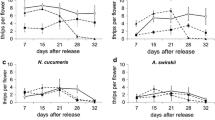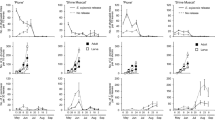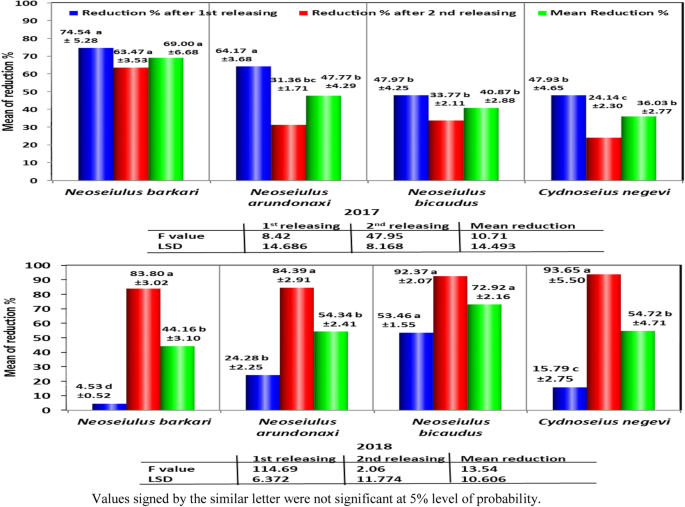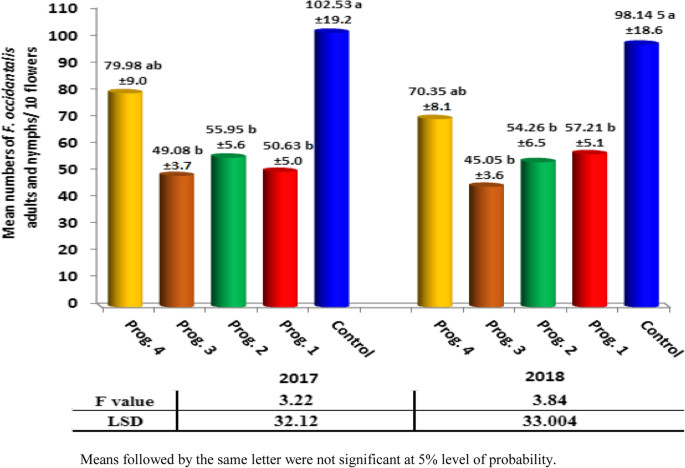Abstract
Two programs for controlling the western flower thrips (WFT), Frankliniella occidentalis (Pergande) (Thysanoptera: Thripidae), were evaluated. Greenhouse experiments were conducted for reducing F. occidentalis populations on pepper plants. The first program was by releasing four phytoseiid predacious mite species namely Neoseiulus arundonaxi (Metwally and Sanad), N. barkeri (Hughes), N. bicaudus (Wainstein), and Cydnoseius negevi (Swirski and Amitai) in the presence of blue sticky traps. The second one was by applying four sequential applications of different pesticides. Results showed that two releases of N. bicaudus, N. barkeri, and N. arundonaxi in the presence of the blue sticky traps reduced WFT population by 45 to 56%. The best control management of the WFT was by the following insecticides: chlorfenapyr, imidacloprid, azadirachtin, and agricultural potassium soap (third program).
Similar content being viewed by others
Explore related subjects
Discover the latest articles, news and stories from top researchers in related subjects.Background
Some abiotic and biotic factors affect pepper production under greenhouse conditions. One of the biotic effects is the western flower thrips (WFT), Frankliniella occidentalis (Pergande) (Thysanoptera: Thripidae). The pest attacks many vegetable plants (Kirişik and Erler 2017). F. occidentalis is characterized by its small size, highly reproductive, and spread capability causing a high infestation rate (Cloyd 2009). The pest deposits its eggs in plant tissue and pupates in the soil or plant litter surrounding plant on the ground, while nymphs and adults inhabit flowers. In a severe infestation, the appropriate pest management was conducted by multiple applications of insecticides (Bethke et al. 2010).
In Egypt, Shalaby (2015) studied the population fluctuation of F. occidentalis on pepper flowers in a greenhouse, while Hanafy (2015) studied its host preference and control techniques on cucumber, squash, eggplant, and kidney bean crops. He indicated that acetamiprid and thiamethoxam gave a high reduction in F. occidentalis population on cucumber. Multiuse of synthetic pesticides had led to a resistance against major insecticide groups (Demirozer et al. 2012). The potential of F. occidentalis was developed extremely fast resistance against neonicotinoid insecticides (Minakuchi et al. 2013). The resistance had been stated for chlorpyrifos and dimethoate (Robb et al. 1995) and against permethrin, methomyl, abamectin, bifenthrin, and chlorpyrifos (Immaraju et al. 1992). The insecticide residue and toxicity problems on marketable pepper crops, towards beneficial organisms (non-target species) and environmental contamination, generated the need of alternative methods to control WFT. Apart from insecticide control, biocontrol agents such as bugs, Orius spp. (Hemiptera: Anthocoridae) as well as plant extracts, are proved to be suitable and effective methods for F. occidentalis control (Arthurs et al. 2009 and Dogramaci et al. 2011).
Several species of the family Phytoseiidae (Acari: Mesostigmata) are important predatory mites on many crops. Numerous phytoseiid species had been reported as effective predators of WFT such as Neoseiulus cucumeris (Oudemans), Amblyseius swirskii (Athias-Henriot), and Amblydromalus limonicus (Garman and McGregor) (Messelink et al. 2006 and Knapp et al. 2013). Neoseiulus barkeri (Hughes) was commonly used as a biological control agent for thrips in pepper (Ramakers 1988). Moreover, few studies had conducted on this pest on pepper crops in Egypt.
The objective of the present study was to evaluate the reduction of F. occidentalis populations on pepper crop under greenhouse conditions by releasing the predatory phytoseiid mites in combination of using of blue sticky traps and/or by applying pesticides.
Materials and methods
The stored grain mite, Tyrophagous putrescentiae (Schrank) (Acari: Acaridae), was collected from debris samples of wheat bran, using modified Tullgren funnels (Krantz and Walter 2009). T. putrescentiae was reared on a mixture of wheat bran and bakery dry yeast at 25 °C in top vented plastic containers (6 × 3 cm, diameters × depth). Mass rearing of the phytoseiid predatory mites was conducted on Tyrophagous putrescentiae. Tested phytoseiid mites were reared constantly on a mixture of all stages of the acarid mite under controlled conditions of 25 ± 2 °C in top-vented plastic containers (6 cm diameter and 10 cm depth). All units were kept in large boxes provided with NaCl-saturated solution for keeping up RH inside the boxes as 75% (Winston and Bates 1960). Releasing of phytoseiid mites was conducted by using of a carrier which consisted of a mixture of wheat bran and vermiculate material by 1:1 ratio.
Greenhouse experiments
Two field experiments were conducted in two symmetrical pepper greenhouses (6 m width × 45 m length × 2.5 m height) in a horticulture farm at Qaha district, Qalyobia Governorate, Egypt, during the period from 12 May to 7 July throughout two successive seasons, 2017 and 2018, under natural infestation conditions. The two greenhouses were cultivated by pepper (Top Star var.). Recommended agricultural practices were applied.
The obtained F. occidentalis individuals from the infested greenhouses were preserved in vials containing 70% ethanol alcohol until identification took place at the Taxonomy Research Department, Plant Protection Research Institute (PPRI), Agriculture Research Center (ARC), Giza, Egypt.
The first experiment was carried out to determine the efficiency of four predatory phytoseiid mites (in the presence of blue sticky trap) to reduce F. occidentalis population in pepper greenhouse. The greenhouse was divided into five blocks (9 × 6 m2/block and 9 × 2 m2/replicates), and each was divided to three replicates. Each block was completely separated by acrylic sheet to prevent mite movement. Thirty blue sticky traps were utilized for attracting of F. occidentalis adults during both seasons in all blocks (each block treatment contained 6 traps). Sticky sheet was (18 cm width × 28 cm length) with a sticky material exposed on both sides. The blue sticky sheet was weekly replaced by new ones. The blue sheet trap (blue sensitive plastic sheet) was obtained from PPRI. The rates and times of releasing of the four predatory phytoseiid mites were presented in Table 1; the releasing of four predatory mites was conducted throughout the flowering stage of pepper plant, due to the F. occidentalis infestation level was highly population.
The second experiment was conducted in a neighbor pepper greenhouse, divided as the first one. All management control programs of WFT used spray of chemical, to be compared with untreated block (Table 2). Comparison between the four programs of insecticides, against WFT and untreated control (check), was conducted throughout the two successive seasons, 2017 and 2018. Pesticide applications were conducted using calibrated handheld compression sprayer (Kwazar) before application. Each block treatment was completely separated by a plastic sheet to avoid pesticide drift.
The mean numbers of WFT individuals (adults and nymphs/10 pepper flowers) were recorded weekly till the end of the experiments. Also, the mean numbers of WFT adults attracted per blue sheet were recorded. Inspection of WFT per ten pepper flowers was carried out, using a white plan sheet (23 cm width × 33 cm length) as inspection plate. The plate was sprayed by water to avoid insects escaping.
Data analysis
Statistical analyses were performed, using SAS program computer including F-test (SAS Institute 2003). Revised least significant differences (LSD) at 5% level of probability were used for comparing means.
Results and discussion
In the untreated check (control), the WFT population recorded three peaks on 19 May, 9 June, and 30 June, 2017, by 33.67, 255.33, and 185.67 individuals per 10 flowers, respectively (Table 3). In the treatments, after 2 June 2017 (first date of releasing), the F. occidentalis individuals decreased by releasing the phytoseiid mites. In the treatment of N. barkeri and N. arundonaxi, a low population of WFT (24.33 and 62.67 individuals/10 flowers, respectively, in season 2017) was recorded after 1 week from releasing. At the second releasing of the four tested predatory mites, the population of WFT increased on the block with N. bicaudus and C. negevi (176.67 and 163.73 individuals/10 flowers, respectively, in 2017 season) (Table 3).
After the second releasing (30 June 2017), the WFT population was sharply dropped after 2 weeks from releasing all phytoseiid mites. The total mean numbers of WFT were 47.60, 39.86, 67.25, 73.87, and 81.13 individuals per 10 flowers in the case of N. barkeri, N. arundonaxi, N. bicaudus, C. negevi, and untreated check, respectively, during the 2017 season (Table 3). Generally, the releasing of both N. barkeri and N. arundonaxi was more effective for WFT suppression in the pepper greenhouse.
In the second season, 2018, the same trend was reported in the four releases of phytoseiid mites against WFT infestation on pepper plants under greenhouse conditions. The releasing of these predators was applied on 19 May and 9 June 2018. During the 2018 season, the population of WFT-infested pepper plant was slowly decreased after the first releasing of predators, while the WFT suppression was rapidly dropped after the two releases in the 2018 season (Table 3). Insignificant differences were recorded among the four releases of the phytoseiid mites throughout the season 2018. In general, the block, released by N. barkeri and N. arundonaxi, harbored the low infestation of WFT, F. occidentalis, during the two successive seasons, 2017 and 2018, under greenhouse. A higher reduction percentage rate in population of WFT on pepper was detected when N. barkeri was released in 2017 (74.54, 63.47, and 69.00% reduction after first and second releases and mean reduction after two releases, respectively), followed by N. arundonaxi recording 64.17, 31.36, and 47.77% reduction in the case of first and second releases and overall mean reduction after two releases, respectively (Fig. 1). However, N. bicaudus and C. negevi recorded the low reduction percentages (overall means of 40.87 and 36.0% reduction, respectively) on F. occidentalis on pepper plant under greenhouse conditions in the 2017 season (Fig. 1).
On the other hand, N. bicaudus and C. negevi caused the higher reduction of F. occidentalis individuals after two releasing processes than the other two predators, N. barkeri and N. arundonaxi, in season 2018. The reduction percentage was 53.46, 24.28, 15.79, and 4.53% after first releases of N. bicaudus, N. arundonaxi, C. negevi, and N. barkeri, respectively, in the second season 2018. After the second releasing, the reduction was 93.65, 92.37, 84.39, and 83.80% for C. negevi, N. bicaudus, N. arundonaxi, and N. barkeri in 2018, respectively. The overall mean reduction percentage was 72.92, 54.72, 54.34, and 44.16% in the second season 2018 with N. bicaudus, C. negevi, N. arundonaxi, and N. barkeri, respectively (Fig. 1).
Generally, the overall mean reduction percentage can be arranged as the following: 56.89, 56.58, 51.05, and 45.38% with N. bicaudus, N. barkeri, N. arundonaxi, and C. negevi, in seasons 2017 and 2018, respectively.
Data in Table 4 show the combined effect of releasing tested phytoseiids and the used of blue sticky trap on pepper plant under greenhouse conditions. The population of WFT individuals/blue sticky sheet recorded three peaks through the tested seasons, 2017 and 2018. The combined effect of predators and sticky traps on the WFT infestations decreased sharply on pepper plants than in the untreated pepper plants (check) (Table 4). The use of predators and blue sticky traps together was more effective for thrips suppression. The means of F. occidentalis individuals/blue sheet during 2017 and 2018 seasons are shown in Table 4. The overall mean of WFT individuals/blue sticky sheet was the highest (63.80 and 34.10 individuals/blue sheet) in block of untreated check, followed by the block of treated one with N. arundonaxi releasing and blue sticky traps (37.90 and 31.20 individuals/blue sticky traps) throughout seasons 2017 and 2018, respectively. Subsequently, the predator-sticky trap combination was more appropriate for WFT controlling on pepper plant under greenhouse conditions through using N. barkeri, N. bicaudus, and N. arundonaxi.
For successful management of F. occidentalis on pepper plants under greenhouse conditions, determination of the thrips damages was critical because the pest had a broad resistance range against insecticides for different chemical categories (Demirozer et al. 2012 and Mouden et al. 2017).
In the present study, using of blue sticky traps was more suitable for reducing and attracting of WFT individuals. Broughton and Harrison (2012) reported that F. occidentalis and T. tabaci were attracted to blue, yellow, and white sticky traps than other tested traps, red, black, and green sticky traps, also in which the blue sticky traps caught the thrip individuals more than the yellow traps. However, current recommendations for attracting of thrips were yellow sticky traps and/or flowers (Hardy et al. 2005). Introducing both blue and yellow sticky cards above the plant was the main method for scouting and controlling of thrips by used about 10–40 sticky cards (Cloyd 2009).
The obtained data reported that the mean reduction percentage of F. occidentalis infestations could be arranged as 56.89, 56.58, 51.05, and 45.38% with N. bicaudus, N. barkeri, N. arundonaxi, and C. negevi, respectively, during the seasons 2017 and 2018. These results were nearly comparable with those findings by Hessien and Parrella (1990) who stated that releasing of N. barkeri led to reduce F. occidentalis individual up to 41% and releasing N. cucmeris or N. barkeri was successful for suppressing of thrips in flower crops. The releasing process was conducted per plant as nearly similar to that reported by Hessien and Parrella (1990) who released N. cucmeris and N. barkeri at (2.5 mites/leaf) against the WFT population. However, the better WFT suppression was achieved when N. cucumeris released at 106 individuals/m2/ biweekly (Van Driesche et al. 2006), while weekly releasing of N. cucumeris (180 individuals/m2) was suitable for F. occidentalis controlling (Bennison et al. 2002). For intensification biological control, N. bicaudus, N. barkeri, and N. arundonaxi framework was an augmentative progress against WFT infestation on pepper greenhouse.
Fortunately, pepper greenhouse provides the suitable media for WFT development and infestation. The chemical control of this pest was difficult. According to these programs, the combined of chemical pesticide and bio-pesticide altogether was used in all these programs of WFT control. The mean numbers of F. occidentalis recorded a high value on check pepper block (untreated check) (89.14 individuals/10 flowers), followed by the fourth program (70.35 individuals/10 flowers) during the first season 2017, while the other three programs stated insignificant differences among them during 2017 season (57.21, 54.26, and 45.05 individuals/10 flowers for the first, second, and third programs, respectively). Similarly, the same trend of results was obtained during the second season 2018. The fourth program of pesticides was reported as a high value of WFT individuals/10 flowers, but the low value was observed on each of third, first, and second programs (49.08, 50.63, and 55.95 WFT individuals/10 flowers during season 2018, respectively (Fig. 2)). Finally, the best WFT control management was the third program, in which sequentially spraying of chlorfenapyr, imidacloprid, azadirachtin, and agricultural potassium soap was used. Data in Fig. 2 illustrates a significant difference between the combination of chemical pesticides and biopesticides in the four tested programs against WFT on pepper plant under greenhouse conditions.
The present data was in harmony with those findings by Hanafy (2015), in which acetamiprid and thiamethoxam gave a significantly high suppression of F. occidentalis, followed by carbosulfan, spinosad, and spinetoram after 14 days from applications. WFT management key by insecticides can be initiated at the low population of F. occidentalis to avoid overlapping of this pest; once it reaches a high population, it is very difficult to control (Cloyd 2009). In the present study, nine different insecticides in four programs were tested against adults and nymphs stages, because the most currently recommended insecticides only suppressed or killed both thrips stages, with no activity on both the eggs and pupal stages (Seaton et al. 1997). The primary rule to prevent or reduce the WFT resistance from insecticide was rotating insecticides use (Robb and Parrella 1995). In the present study, numerous pesticides were rotated against WFT population on pepper plants under greenhouse conditions. For example, WFT populations were recorded to be resistance against carbamate, pyrethroid, and organophosphates (Kontsedalov et al. 1998). Finally, releasing of N. bicaudus and N. barkeri in combination with blue sticky cards reduced the WFT by 56.89 and 56.58%, respectively. The application of the third program (sequential spraying of chlorfenapyr, imidacloprid, azadirachtin, and agricultural potassium soap) gave the best results in reducing the (WFT) (47.1 mean numbers of individuals/10 flowers during the two seasons).
Conclusion
In the present study, releasing of N. bicaudus, N. barkeri, N. arundonaxi, and C. negevi in combination with the blue sticky traps reduced F. occidentalis individuals up to 56% and can be recommended for controlling F. occidentalis on pepper plantations in the greenhouses.
Availability of data and materials
Not applicable
References
Arthurs S, Mckenzie CL, Chen J, Dogramaci M, Brennan M, Houben K, Osborne L (2009) Evaluation of Neoseiulus cucumeris and Amblyseius swirskii (Acari: Phytoseiidae) as biological control agents of chilli thrips, Scirtothrips dorsalis (Thysanoptera: Thripidae) on pepper. Biol Cont 49(1):91–96
Bennison J, Maulden K, Maher H (2002) Choice of predatory mites for biological control of ground-dwelling stages of western flower thrips within a ‘push-pull’ strategy on pot chrysanthemum. Bulletin OILB/SROP 25:9–12
Bethke, J.; Chamberlin, J.; Dobbs, J.; Faver, M.; Heinz, K.; Lindquist, R.; Ludwig, S.; Mckenzie, C.L.; Murphy, G.; Oetting, R.; Osborne, L.; Palmer, C.; Parrella, M.; Rechcigl, N. and Yates, R. (2010): Thrips management program for plants for planting. Mid Florida Research & Education Center, Univ. Florida, 1-9 pp.
Broughton S, Harrison J (2012) Evaluation of monitoring methods for thrips and the effect of trap colour and semiochemicals on sticky trap capture of thrips (Thysanoptera) and beneficial insects (Syrphidae, Hemerobiidae) in deciduous fruit trees in Western Australia. Crop Protection 42:156–163
Cloyd RA (2009) Western flower thrips (Frankliniella occidentalis) management on ornamental crops grown in greenhouses: have we reached an impasse? Pest Technology 3:1–9
Demirozer O, Tyler-Julian K, Funderburk J, Leppla N, Reitz SR (2012) Frankliniella occidentalis (Pergande) integrated pest management programs for fruiting vegetables in Florida. Pest Manag Sci 68:1537–1545
Dogramaci M, Arthurs SP, Chen J, McKenzie CL, Irrizary F, Osborne LS (2011) Management of Chilli thrips, Scirtothrips dorsalis (Thysanoptera: Thripidae) on peppers by Amblyseius swirskii (Acari: Phytoseiidae) and Orius insidiosus (Hemiptera: Anthocoridae). Biol Cont. 59(3):340–347
Hanafy ARI (2015) Population fluctuation, host preference, damage and control of western flower thrips, Frankliniella occidentalis (Pergande) on some vegetable crops in Egypt. Egypt Acad J Biolog Sci 8(1):145–156
Hardy, S.; Steiner, M.; Thwaite, G. (2005): Plague thrips and western flower thrips. In: Integrated Pest and Disease Management for Australian Summerfruit. NSW Department of Primary Industries, NSW, Summerfruit Australia Inc, 65-69 pp.
Hessein NA, Parrella MP (1990) Predatory mites help control thrips on floriculture crops. California Agriculture 44:19–21
Immaraju JA, Paine TD, Bethke JA, Robb KL, Newman JP (1992) Western flower thrips (Thysanoptera: Thripidae) resistance to insecticides in coastal California greenhouses. J Econ Entomol 85:9–14
Kirişik M, Erler F (2017) The usage possibilities of entomopathogenic fungi in the control of western flower thrips, Frankliniella occidentalis (Pergande) (Thysanoptera: Thripidae). Turkish J Entomol 7(4):293–303
Knapp M, van Houten Y, Hoggerbrugge H, Bolckmans K (2013) Amblydromalus limonicus (Acari: Phytoseiidae) as a biocontrol agent: review and new findings. Acaralogia 53:102–202
Kontsedalov S, Weintraub PG, Horowitz AR, Ishaaya I (1998) Effects of Insecticides on Immature and Adult Western Flower Thrips (Thysanoptera: Thripidae) in Israel. J Econ Entomol 91(5):1067–1071
Krantz GW, Walter DE (2009) A manual of acarology: third edition, Texas Tech. University Press, USA, 816 pp
Messelink GJ, Steenpaal SEF, Ramakers PMJ (2006) Evaluation of phytoseiid predators for control of Western flower thrips on greenhouse cucumber. Biocontrol 51:753–768
Minakuchi C, Inano Y, Shi X, Song D, Zhang Y, Miura K, Sonoda S (2013) Neonicotinoid resistance and cDNA sequences of nicotinic acetylcholine receptor subunits of the western flower thrips Frankliniella occidentalis (Thysanoptera: Thripidae). Appl Entomol Zool 48(4):507–513
Mouden S, Sarmiento KF, Klinkhamer PGL, Leiss KA (2017) Integrated pest management in western flower thrips: past, present and future. Pest Manag Sci 73:813–822
Ramakers PMJ (1988) Population dynamics of the thrips predators Amblyseius mckenziei and Amblyseius cucumeris (Acarina: Phytoseiidae) on sweet pepper. Netherlands J Agricul Sci 36:247–252
Robb KL, Newman J, Virzi JK, Parrella MP (1995) Insecticide resistance in western flower thrips. In: Parker BL, Skinner M, Lewis T (eds) Thrips Biology and Management. Plenum Press, New York, pp 341–346
Robb KL, Parrella MP (1995) IPM of western flower thrips. In: Parker BL, Skinner M, Lewis T (eds) Thrips Biology and Management. Plenum Press, New York, pp 365–370
SAS Institute (2003): Statistical Analysis System, SAS Release 9.1 for windows, SAS Institute Inc.Cary, NC, USA.
Seaton KA, Cook DF, Hardie DC (1997) The effectiveness of a range of insecticides against western flower thrips (Frankliniella occidentalis) (Thysanoptera:Thripidae) on cut flowers. Aust J Agric Res 48:781–788
Shalaby, H.H. (2015): Preliminary study on the control of western flower thrips, Frankliniella occidentalis (Pergande) in pepper crop greenhouses in Qalyubia Governorate, Egypt. J Plant Prot Path., Mansoura Univ., 6(1): 155-167.
Van Driesche RG, Lyon S, Stanek EJ, Xu B, Nunn C (2006) Evaluation of efficacy of Neoseiulus cucumeris for control of Western flower thrips in spring bedding crops. Biol Control 36:203–215
Winston PW, Bates DH (1960) Saturated solutions for the control of humidity in biological research. Ecology 41:232–237
Acknowledgements
Not applicable
Funding
No funding
Author information
Authors and Affiliations
Contributions
ASS and GMH contributed to the suggesting and putting of the idea, preparing of the manuscript writing and finishing of the paper, and data analysis. All authors contribute by 100% participation. Both authors read and approved the final manuscript.
Corresponding author
Ethics declarations
Ethics approval and consent to participate
Not applicable
Consent for publication
Not applicable
Competing interests
The authors declare that they have no competing interests.
Additional information
Publisher’s Note
Springer Nature remains neutral with regard to jurisdictional claims in published maps and institutional affiliations.
Rights and permissions
Open Access This article is distributed under the terms of the Creative Commons Attribution 4.0 International License (http://creativecommons.org/licenses/by/4.0/), which permits unrestricted use, distribution, and reproduction in any medium, provided you give appropriate credit to the original author(s) and the source, provide a link to the Creative Commons license, and indicate if changes were made.
About this article
Cite this article
Sanad, A.S., Hassan, G.M. Controlling the western flower thrips, Frankliniella occidentalis (Pergande) (Thysanoptera: Thripidae) by releasing the predatory phytoseiid mites and pesticides on pepper in a greenhouse. Egypt J Biol Pest Control 29, 95 (2019). https://doi.org/10.1186/s41938-019-0186-9
Received:
Accepted:
Published:
DOI: https://doi.org/10.1186/s41938-019-0186-9






